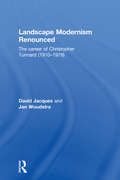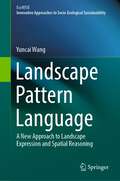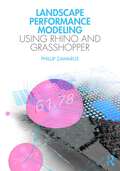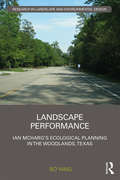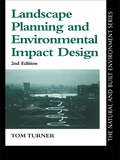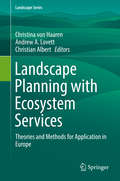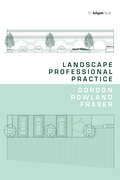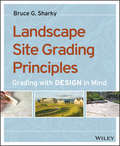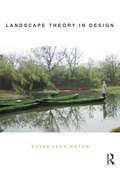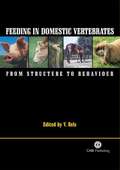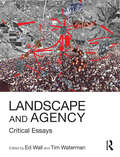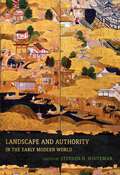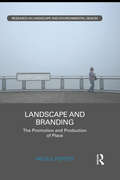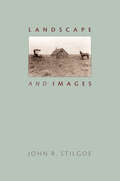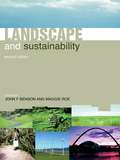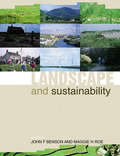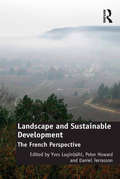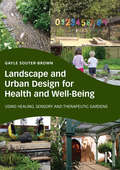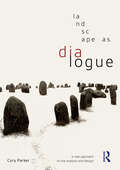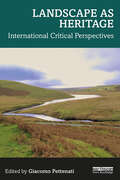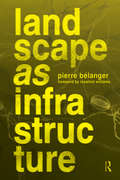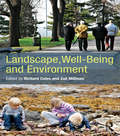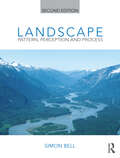- Table View
- List View
Landscape Modernism Renounced: The Career of Christopher Tunnard (1910-1979)
by Jan Woudstra David JacquesBefore the Second World War landscape architect Christopher Tunnard was the first author on Modernism in Landscape in the English language, but later became alarmed by the destructive forces of Post-war reconstruction. Between the 1950s and the 1970s he was in the forefront of the movement to save the city, becoming an acclaimed author sympathetic to preservation. Ironically it was the Modernist ethos that he had so fervently advocated before the war that was the justification for the dismemberment of great cities by officials, engineers and planners. This was not the first time that Tunnard had to re-evaluate his principles, as he had done so in the 1930s in rejecting Arts-and-Crafts in favour of Modernism. This book tracks his changing ideology, by reference to his writings, his colleagues and his work. Christopher Tunnard is one of the most influential figures in Landscape Architecture and his journey is one that still resonates in the discipline today. His leading role in first embracing the tenets of Modernism and then moving away from to embrace a more conservationist approach can be seen in the success and impact on the profession of those with whom he worked and taught.
Landscape Pattern Language: A New Approach to Landscape Expression and Spatial Reasoning (EcoWISE)
by Yuncai WangThis book presents a landscape pattern language framework for describing landscape spaces and offers a new approach to landscape expression and spatial reasoning. In addition to describing a conceptual model of landscape pattern language and its inner logical connections, the book discusses the functionality of landscape pattern language from both local and universal perspectives—effectively demonstrating that it can be used to highlight the individuality and characteristics of landscape space shaping. Given its scope, the book offers a valuable resource for all graduate students, lecturers, researchers, and practitioners in the areas of landscape architecture, landscape planning, and regional planning, especially ecological planning and design.
Landscape Performance Modeling Using Rhino and Grasshopper
by Phillip ZawarusThis is a guidebook for landscape architects to learn the fundamental practices and use of the computational software Rhino 3D and the plugin Grasshopper for parametric modeling, landscape inventory, and performative analysis. This process visually connects intangible and abstract information with physical and spatial relationships to signify the impact ecological, climate, and cultural factors have on landscape performance and decision making. Each chapter begins with a summary of the performance method and its application in different projects, outlining the expected goals from industry standard equations and operations. Chapters cover parametric modeling scripts to measure ecosystem services of stormwater management, erosion control, tree benefits, outdoor comfort, accessibility, and many others. Using photographs, tables, and parametric scripts to create qualitative and quantitative representations of landscape performance and ecosystem services, readers will learn to communicate the impact and significance of their outputs. This book will be beneficial to educators, students, and professionals interested in using computational modeling as a performance assessment and graphic visualization tool.
Landscape Performance: Ian McHarg’s ecological planning in The Woodlands, Texas (Routledge Research in Landscape and Environmental Design)
by Bo YangIan McHarg’s ecological planning approach has been influential since the 20th century. However, few empirical studies have been conducted to evaluate the performance of his projects. Using the framework of landscape performance assessment, this book demonstrates the long-term benefits of a renowned McHargarian project (The Woodlands town development) through quantitative and qualitative methods. Including 44 black and white illustrations, Landscape Performance systematically documents the performance benefits of the environmental, social, and economic aspects of The Woodlands project. It delves into McHarg’s planning success in The Woodlands in comparison with adjacent Houston developments, which demonstrated urban resilience after Hurricane Harvey in 2017. Lastly, it identifies the ingredients of McHarg’s ability to do real and permanent good. Yang also includes a number of appendices which provide valuable information on the methods of assessing performance in landscape development. This book would be beneficial to academics and students of landscape architecture and planning with a particular interest in Ian McHarg.
Landscape Planning And Environmental Impact Design
by Tom TurnerWritten for use in undergraduate and postgraduate planning courses and for those involved in all aspects of the planning process, this comprehensive textbook focuses on environmental impact assessment and design and in particular their impact on planning for the landscape.
Landscape Planning with Ecosystem Services: Theories and Methods for Application in Europe (Landscape Series #24)
by Christina Von Haaren Andrew A. Lovett Christian AlbertHuman well-being depends in many ways on maintaining the stock of natural resources which deliver the services from which human’s benefit. However, these resources and flows of services are increasingly threatened by unsustainable and competing land uses. Particular threats exist to those public goods whose values are not well-represented in markets or whose deterioration will only affect future generations. As market forces alone are not sufficient, effective means for local and regional planning are needed in order to safeguard scarce natural resources, coordinate land uses and create sustainable landscape structures. This book argues that a solution to such challenges in Europe can be found by merging the landscape planning tradition with ecosystem services concepts. Landscape planning has strengths in recognition of public benefits and implementation mechanisms, while the ecosystem services approach makes the connection between the status of natural assets and human well-being more explicit. It can also provide an economic perspective, focused on individual preferences and benefits, which helps validate the acceptability of environmental planning goals. Thus linking landscape planning and ecosystem services provides a two-way benefit, creating a usable science to meet the needs of local and regional decision making. The book is structured around the Driving forces-Pressures-States-Impacts-Responses framework, providing an introduction to relevant concepts, methodologies and techniques. It presents a new, ecosystem services-informed, approach to landscape planning that constitutes both a framework and toolbox for students and practitioners to address the environmental and landscape challenges of 21st century Europe.
Landscape Plants: Their Identification, Culture, and Use (2nd edition)
by Ferrell M. BridwellIntended to help students, nursery people, landscape architects, educators, and homeowners in accurately identifying and growing an array of mostly typical woody landscape plants. A beginning chapter discusses plant identification and characteristics as well as the functional and aesthetic uses of plants. The remaining chapters present the plants, with one page of text and several passable color photos devoted to each. Information provided includes hardiness zones (mostly USDA zones 5 to 9), dimensions, fruit, texture, growth rate, culture, pest problems, habit, family, leaf and flower characteristics, selections and cultivars in cultivation, and landscape notes. Entries include ground covers; vines; dwarf, medium, and large shrubs; small, medium, and large trees; and grasses, palms, and bamboo.
Landscape Professional Practice
by Gordon Rowland FraserGraduate of the Royal Botanic Gardens, Kew, Chartered Landscape Architect, MBA and Barrister, Gordon Rowland Fraser draws upon 30 years of project management, professional practice and teaching experience to provide an uncomplicated and intuitive guide to the business aspects of the landscape profession. An indispensable reference for seasoned professionals, the book will enable the student or novice practitioner to turn their drawing board inspiration into reality without being overwhelmed or afraid of overseeing the implementation of their proposals. Guided by the Landscape Institute’s 2013 Pathway to Chartership syllabus, this structured, step-by-step, narrative guide sets out the documentation commonly used within the landscape profession and makes accessible a logical and sequential understanding of contractual relationships; procurement strategies; processes of preparing client estimates and obtaining competitive quotations; of preparing contract documentation and administering formal contracts; general concepts of law as they relate to land management and the landscape profession; of business administration, market appraisal and positioning; and of the landscape consultant’s appointment. As an understanding of professional practice is intrinsic to all Landscape Institute accredited courses, this is an essential text for every landscape architecture student during their education and their subsequent journey into professional practice. Those undertaking Garden Design Diplomas will similarly find the book invaluable as they venture into the world of creativity and commerce, while the seasoned practitioner will find it a comprehensive point of reference to add to their bookshelf.
Landscape Professional Practice
by Gordon Rowland FraserGraduate of the Royal Botanic Gardens, Kew, Chartered Landscape Architect, MBA and Barrister, Gordon Rowland Fraser draws upon 30 years of project management, professional practice and teaching experience to provide an uncomplicated and intuitive guide to the business aspects of the landscape profession. An indispensable reference for seasoned professionals, the book will enable the student or novice practitioner to turn their drawing board inspiration into reality without being overwhelmed or afraid of overseeing the implementation of their proposals. Guided by the Landscape Institute’s 2013 Pathway to Chartership syllabus, this structured, step-by-step, narrative guide sets out the documentation commonly used within the landscape profession and makes accessible a logical and sequential understanding of contractual relationships; procurement strategies; processes of preparing client estimates and obtaining competitive quotations; of preparing contract documentation and administering formal contracts; general concepts of law as they relate to land management and the landscape profession; of business administration, market appraisal and positioning; and of the landscape consultant’s appointment. As an understanding of professional practice is intrinsic to all Landscape Institute accredited courses, this is an essential text for every landscape architecture student during their education and their subsequent journey into professional practice. Those undertaking Garden Design Diplomas will similarly find the book invaluable as they venture into the world of creativity and commerce, while the seasoned practitioner will find it a comprehensive point of reference to add to their bookshelf.
Landscape Site Grading Principles
by Bruce G. SharkyA complete guide to site grading for designers and other visual learnersGrading With Design in Mind: Landscape Site Grading Principles is a comprehensive guide to grading, written specifically from the design perspective. Heavily illustrated and non-technical, this book meets the needs of designers and visual learners by presenting the principles and methods of site grading with less emphasis on engineering, and a strong focus on the effect on the overall aesthetic. Written by a professor in America's number-one ranked undergraduate landscape architecture program, the book guides readers step-by-step through the process of solving various grading problems in real-life scenarios.Landscape designers, landscape architects, and engineers need to have a deep understanding of site grading as the foundation of any project. Grading plans must not only solve practical requirements, but also create landforms that contribute to the aesthetic ambition of the overall site and architectural design concept. Grading With Design in Mind takes a highly visual approach to presenting modern grading techniques and considerations, providing designers the guidance they need to become competent in site grading while understanding the design implications of the subject. Features include:Numerous illustrations to support the textStep-by-step examplesProfessional grading plansStudying the professional grading plans helps readers better understand the real-world application of grading principles in different situations. Site grading is a complicated topic with plenty of on-site variables, but Grading with Design in Mind breaks it down into clear, concise instruction with value to both professionals and students in the field of landscape design.
Landscape Theory in Design
by Susan HerringtonPhenomenology, Materiality, Cybernetics, Palimpsest, Cyborgs, Landscape Urbanism, Typology, Semiotics, Deconstruction - the minefield of theoretical ideas that students must navigate today can be utterly confusing, and how do these theories translate to the design studio? Landscape Theory in Design introduces theoretical ideas to students without the use of jargon or an assumption of extensive knowledge in other fields, and in doing so, links these ideas to the processes of design. In five thematic chapters Susan Herrington explains: the theoretic groundings of the theory of philosophy, why it matters to design, an example of the theory in a work of landscape architecture from the twentieth and twenty-first centuries, debates surrounding the theory (particularly as they elaborate modern and postmodern thought) and primary readings that can be read as companions to her text. An extensive glossary of theoretical terms also adds a vital contribution to students’ comprehension of theories relevant to the design of landscapes and gardens. Covering the design of over 40 landscape architects, architects, and designers in 111 distinct projects from 20 different countries, Landscape Theory in Design is essential reading for any student of the landscape.
Landscape Trees and Shrubs
by Mary ForrestThis book presents a horticultural overview of the main plant families of trees and shrubs from temperate regions that are cultivated in urban and rural landscape schemes. Most of the plants used come from a limited number of plant families and within these families, certain genera contribute very significantly.The largest chapter in the book describes 37 plant families according to their identification, functional use and management in landscape schemes. With this information readers will be able to assess the suitability of species and prepare planting designs for prevailing sites.
Landscape and Agency: Critical Essays
by Tim Waterman Ed WallLandscape and Agency explores how landscape, as an idea, a visual medium and a design practice, is organized, appropriated and framed in the transformation of places, from the local to the global. It highlights how the development of the idea of agency in landscape theory and practice can fundamentally change our engagement with future landscapes. Including a wide range of international contributions, each illustrated chapter investigates the many ways in which the relationship between the ideas and practices of landscape, and social and subjective formations and material processes, are invested with agency. They critically examine the role of landscape in processes of contemporary urban development, environmental debate and political agendas and explore how these relations can be analysed and rethought through a dialogue between theory and practice.
Landscape and Authority in the Early Modern World (Penn Studies in Landscape Architecture)
by John Dixon HuntCourts and societies across the early modern Eurasian world were fundamentally transformed by the physical, technological, and conceptual developments of their era. Evolving forms of communication, greatly expanded mobility, the spread of scientific knowledge, and the emergence of an increasingly integrated global economy all affected how states articulated and projected visions of authority into societies that, in turn, perceived and responded to these visions in often contrasting terms. Landscape both reflected and served as a vehicle for these transformations, as the relationship between the land and its imagination and consumption became a fruitful site for the negotiation of imperial identities within and beyond the precincts of the court.In Landscape and Authority in the Early Modern World, contributors explore the role of landscape in the articulation and expression of imperial identity and the mediation of relationships between the court and its many audiences in the early modern world. Nine studies focused on the geographical areas of East and South Asia, the Islamic world, and Europe illuminate how early modern courts and societies shaped, and were shaped by, the landscape, including both physical sites, such as gardens, palaces, cities, and hunting parks, and conceptual ones, such as those of frontiers, idealized polities, and the cosmos.The collected essays expand the meaning and potential of landscape as a communicative medium in this period by putting an array of forms and subjects in dialogue with one another, including not only unique expressions, such as gardens, paintings, and manuscripts, but also the products of rapidly developing commercial technologies of reproduction, especially print. The volume invites a deeper and more nuanced understanding of the complexity with which early modern states constructed and deployed different modes of landscape for different audiences and environments.Contributors: Robert Batchelor, Seyed Mohammad Ali Emrani, John Finlay, Caroline Fowler, Katrina Grant, Finola O’Kane, Anton Schweizer, Larry Silver, Stephen H. Whiteman.
Landscape and Branding: The promotion and production of place (Routledge Research in Landscape and Environmental Design)
by Nicole PorterLandscape and branding explores the way landscape is conceptualised, conceived, represented and designed by professionals in a brand-driven age. Landscape - incorporating tangible physical space as well as intangible concepts, narratives, images, and experiences of place - is constructed by a number of creative industries. This book tests the hypothesis that place branding, a powerful marketing and management practice, increasingly blurs the distinction between the promotion of landscape and its production in design terms. Place branding involves the strategic and systematic composition of single-minded, experiential and market-friendly place identities which are consistently communicated across various media, including physical space. How does this implicate or transform notions of place, nature, landscape experience, and the qualitative value of landscape itself? How does this affect the role of landscape architecture? To answer these questions, place branding theory and practice is critically examined alongside an in depth case study of one specific landscape - the Blue Mountains (Australia). Projects undertaken between 1995 and 2015, including a branding strategy for the region, media campaigns, television, cinema, and several landscape architectural works in the public and private domain are comparatively analysed, focusing on the discourse, conventions and values informing their production, and the landscape narratives they convey.
Landscape and Images
by John R. StilgoeJohn Stilgoe is just looking around. This is more difficult than it sounds, particularly in our mediated age, when advances in both theory and technology too often seek to replace the visual evidence before our own eyes rather than complement it. We are surrounded by landscapes charged with our past, and yet from our earliest schooldays we are instructed not to stare out the window. Someone who stops to look isn't only a rarity; he or she is suspect. Landscape and Images records a lifetime spent observing America's constructed landscapes. Stilgoe's essays follow the eclectic trains of thought that have resulted from his observation, from the postcard preference for sunsets over sunrises to the concept of "teen geography" to the unwillingness of Americans to walk up and down stairs. In Stilgoe's hands, the subject of jack o' lanterns becomes an occasion to explore centuries-old concepts of boundaries and trespassing, and to examine why this originally pagan symbol has persisted into our own age. Even something as mundane as putting the cat out before going to bed is traced back to fears of unwatched animals and an untended frontier fireplace. Stilgoe ponders the forgotten connections between politics and painted landscapes and asks why a country whose vast majority lives less than a hundred miles from a coast nonetheless looks to the rural Midwest for the classic image of itself.At times breathtaking in their erudition, the essays collected here are as meticulously researched as they are elegantly written. Stilgoe's observations speak to specialists--whether they be artists, historians, or environmental designers--as well as to the common reader. Our landscapes constitute a fascinating history of accident and intent. The proof, says Stilgoe, is all around us.
Landscape and Sustainability
by Maggie Roe John F BensonThis unique book addresses the issue of sustainability from the point of view of landscape architecture, dealing with professional practices of planners, designers and landscape managers. This second edition contains updated and new material reflecting developments during the last five years and comprehensively addresses the relationship between landscape architecture and sustainability. Much in the text is underpinned by landscape ecology, in contrast to the idea of landscape as only appealing to the eye or aspiring cerebrally to be fine art. Landscape and Sustainability establishes that the sustainability agenda needs a new mindset among professionals: the driving question must always be ‘is it sustainable?’ Developing theory into practice, from the global to the local scale and from issues of policy and planning through to detailed design and implementation and on to long-term maintenance and management, the contributors raise and re-examine a complex array of research, policy and professional issues and agendas to contribute to the necessary ongoing debate about the future of both landscape and sustainability.
Landscape and Sustainability
by John F. Benson Maggie H. RoeThis unique book is about landscape, sustainability and the practices of the professions which plan, design and manage landscapes at many scales and in many locations; urban, suburban and rural. Despite the ubiquity of 'sustainability' as a concept, this is the first book to address the relationship between landscape architecture and sustainability in a comprehensive way.Much in the book is underpinned by landscape ecology, in contrast to the idea of landscape as only appealing to the eye or aspiring cerebrally to be fine art. As this book argues, landscape is and must be much more than this; landscape architecture is about making places which are biologically wholesome, socially just and spiritually rewarding.
Landscape and Sustainable Development: The French Perspective
by Peter Howard Yves LuginbühlPreviously published in French by Éditions Quae, this volume presents findings of a major research programme into landscape and sustainable development. While led by French scholars, the research team and geographical scope of the project was international, collaborative and comparative. Using case studies from across Europe, the interdisciplinary team of contributors discuss the relationship between landscape as defined by the European Landscape Convention and the concept of sustainable development. This English edition has a new introduction written by Yves Luginbühl and Peter Howard. The book is then divided into three sections: Biophysical Realities and Landscape Practice; Landscape Resources-Inheritance and Renewal; Governance and Participation. Some of the topics covered, such as wind-farm landscapes, will be familiar to English language readers, but others, such as footpath economics, non-woodland trees, inter-generational equity, and the insistence on the necessary developments in governance less so.
Landscape and Urban Design for Health and Well-Being: Using Healing, Sensory and Therapeutic Gardens
by Gayle Souter-BrownIn this book Gayle Souter-Brown explores the social, economic and environmental benefits of developing greenspace for health and well-being. She examines the evidence behind the positive effects of designed landscapes, and explains effective methods and approaches which can be put into practice by those seeking to reduce costs and add value through outdoor spaces. Using principles from sensory, therapeutic and healing gardens, Souter-Brown focuses on landscape’s ability to affect health, education and economic outcomes. Already valued within healthcare environments, these design guidelines for public and private spaces extend the benefits throughout our towns and cities. Covering design for school grounds to public parks, public housing to gardens for stressed executives, this richly illustrated text builds the case to justify inclusion of a designed outdoor area in project budgets. With case studies from the US, UK, Africa, Asia, Australasia and Europe, it is an international, inspirational and valuable tool for those interested in landscapes that provide real benefits to their users.
Landscape as Dialogue: A New Approach to Site Analysis and Design
by Cory ParkerLandscape as Dialogue redefines the process of understanding landscapes for students and practitioners so they can create more integrated, healthy places. Traditional site analysis sees the landscape as a series of components, evaluated individually, before being put back together. This perpetuates existing social hierarchies, maintains the need for high energy inputs and trumpets iconic designs that contribute to gentrification. This book examines the process of landscape dialogue as a natural give and take with the environment, drawing on diverse and challenging writings from design, geography, philosophy and ecological sciences to probe the relationship between humans and landscape. Each chapter begins with a discussion of a theoretical approach to landscape dialogue, such as perception, information or critique, before offering a series of practical steps and representation techniques that designers can use in understanding the landscape. Detailed illustrated case studies from around the world, including Hawaii, the American Southwest, Japan, China, Mexico, Turkey and Peru, explore the book’s lessons in practice. This must-read book offers a radical alternative to conventional analytical approaches, inspiring designers to fully engage in the landscape to ultimately generate ecologically considered places.
Landscape as Heritage: International Critical Perspectives
by Giacomo PettenatiThis edited book provides a broad collection of current critical reflections on heritage-making processes involving landscapes, positioning itself at the intersection of landscape and heritage studies. Featuring an international range of contributions from researchers, academics, activists, and professionals, the book aims to bridge the gap between research and practice and to nourish an interdisciplinary debate spanning the fields of geography, anthropology, landscape and heritage studies, planning, conservation, and ecology. It provokes critical enquiry about the challenges between heritage-making processes and global issues, such as sustainability, economic inequalities, social cohesion, and conflict, involving voices and perspectives from different regions of the world. Case studies in Italy, Portugal, Spain, Slovenia, the Netherlands, Turkey, the UK, Columbia, Brazil, New Zealand, and Afghanistan highlight different approaches, values, and models of governance. This interdisciplinary book will appeal to researchers, academics, practitioners, and every landscape citizen interested in heritage studies, cultural landscapes, conservation, geography, and planning.
Landscape as Infrastructure: A Base Primer
by Pierre BelangerAs ecology becomes the new engineering, the projection of landscape as infrastructure—the contemporary alignment of the disciplines of landscape architecture, civil engineering, and urban planning— has become pressing. Predominant challenges facing urban regions and territories today—including shifting climates, material flows, and population mobilities, are addressed and strategized here. Responding to the under-performance of master planning and over-exertion of technological systems at the end of twentieth century, this book argues for the strategic design of "infrastructural ecologies," describing a synthetic landscape of living, biophysical systems that operate as urban infrastructures to shape and direct the future of urban economies and cultures into the 21st century. Pierre Bélanger is Associate Professor of Landscape Architecture and Co-Director of the Master in Design Studies Program at Harvard University’s Graduate School of Design. As part of the Department of Landscape Architecture and the Advansed Studies Program, Bélanger teaches and coordinates graduate courses on the convergence of ecology, infrastructure and urbanism in the interrelated fields of design, planning and engineering. Dr. Bélanger is author of the 35th edition of the Pamphlet Architecture Series from Princeton Architectural Press, GOING LIVE: from States to Systems (pa35.net), co-editor with Jennifer Sigler of the 39th issue of Harvard Design Magazine, Wet Matter, and co-author of the forthcoming volume ECOLOGIES OF POWER: Mapping Military Geographies & Logistical Landscapes of the U.S. Department of Defense. As a landscape architect and urbanist, he is the recipient of the 2008 Canada Prix de Rome in Architecture and the Curator for the Canada Pavilion ad Canadian Exhibition, "EXTRACTION," at the 2016 Venice Architecture Biennale (extraction.ca).
Landscape, Well-Being and Environment
by Richard Coles Zoë MillmanWell-being is now firmly established as an overarching theme of key concern to all professionals that work, manage or design the environment. However, well-being is a complex multi-dimensional issue rooted in the ways that we encounter, perceive and interpret the environment. No single discipline can claim to have sufficient knowledge to fully explain the types of interactions that occur, therefore there is a need to draw together a wide range of professions who are exploring the consequences of their actions upon the well-being of individuals and communities. This edited work addresses the above, consisting of a collection of studies which embrace different aspects of environment, landscape and well-being to consider current approaches to well-being research and practice that fall outside the traditional concepts of well-being as part of medical research, making links with architecture, landscape design, environmental perception, social interaction and environmental sustainability. The contributors originally presented at the international conference, ‘Well-Being 2011’ jointly hosted by Birmingham City University and the Royal Institute of British Architects (RIBA); the chapters have been developed to present a coherent series of themes reviewing a wide range of literature, presenting case studies appropriate to diverse audiences.
Landscape: Pattern, Perception and Process
by Simon BellLandscapes develop and evolve through an interacting series of processes – climatic, geological, ecological and cultural – over varying periods of time. These processes shape the structure and character of the landscapes which we experience. Over time, distinctive patterns emerge – ranging in scale from the distribution of small plants to the sculptured sides of a huge canyon. Our perception of these patterns goes beyond just their visual appreciation – beautiful though they may be – into a richer understanding of how we experience our environment. By understanding this complex pattern–process interaction we can obtain a deeper awareness of landscape and our place in it – as inhabitants and as shapers. The book explores the nature of patterns and ways of classifying them before studying the nature of perception (primarily visual but including other senses), then proceeds to relate this perception to aesthetics and from there to the design process. From this point the main driving processes in landscape are introduced alongside the resulting patterns, these being climatic, landform, ecosystem and cultural aspects. It is this integrative approach of looking at landscape as a kind of self-organising system, overlaid by conscious human planning activities and the unity of pattern and process, which makes this book unique. Landscape draws from a wide range of neighbouring disciplines, of which the landscape planner or designer needs to be aware, but which are often taught as distinct elements. Bell binds these fundamentals together, which enables the landscape to be ‘read’, and this reading to be used as the basis for planning and design. This second edition updates and refreshes the original material with added sections and new photos, particularly making use of the developments in satellite photography. Featuring full colour throughout, this textbook is ideal for anyone studying landscape architecture or any of the disciplines which intersect with the landscape, and which affect it.
